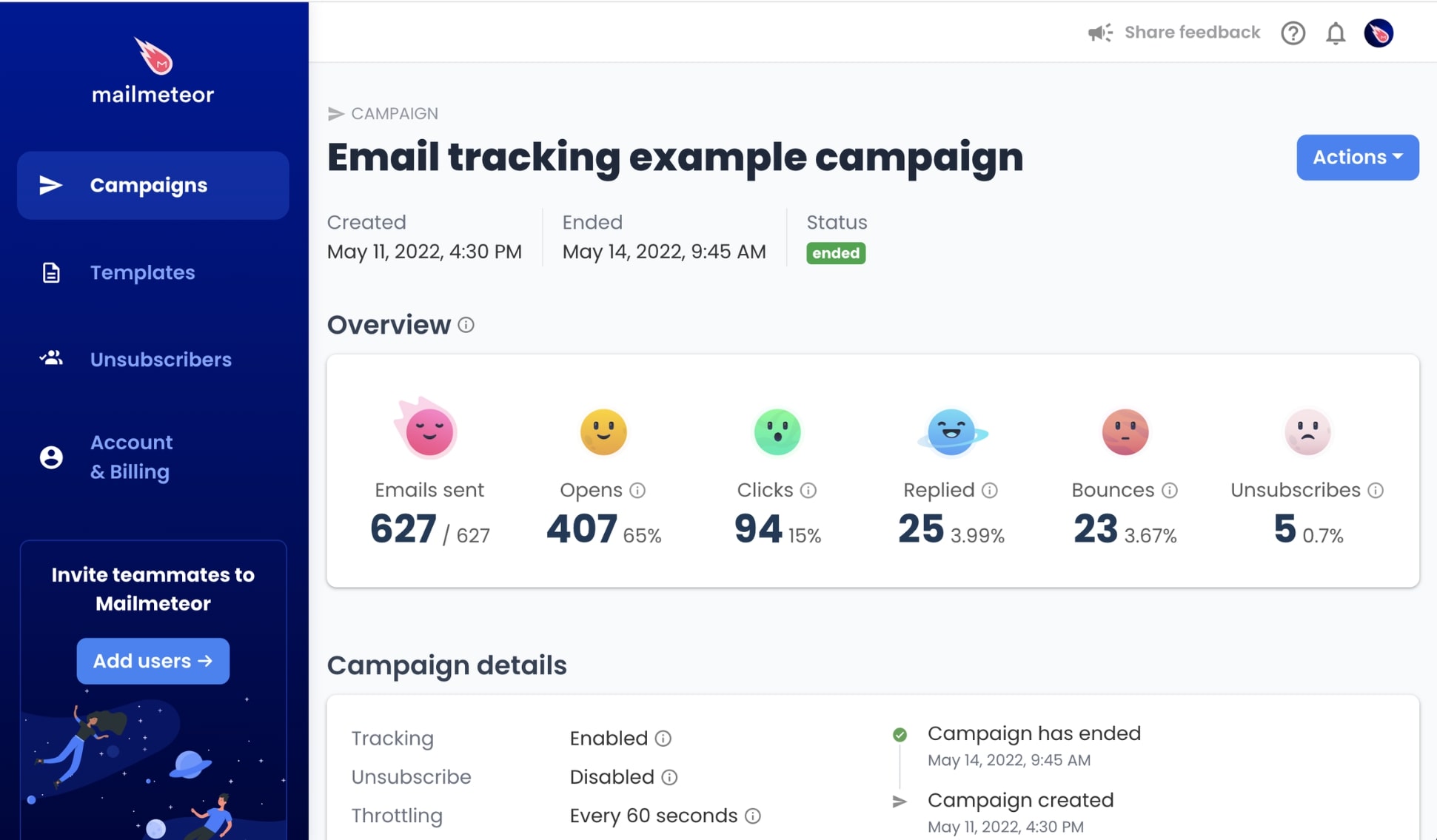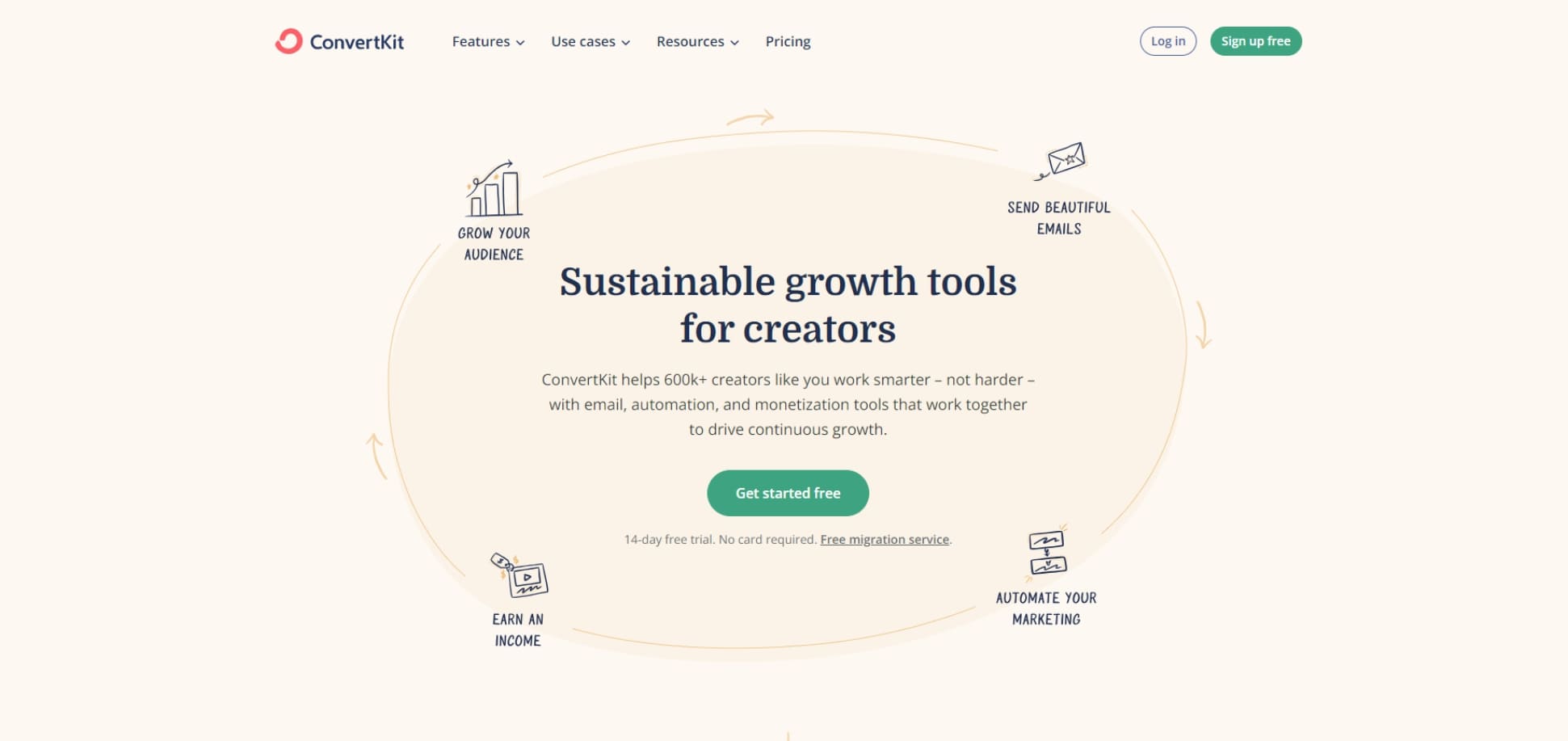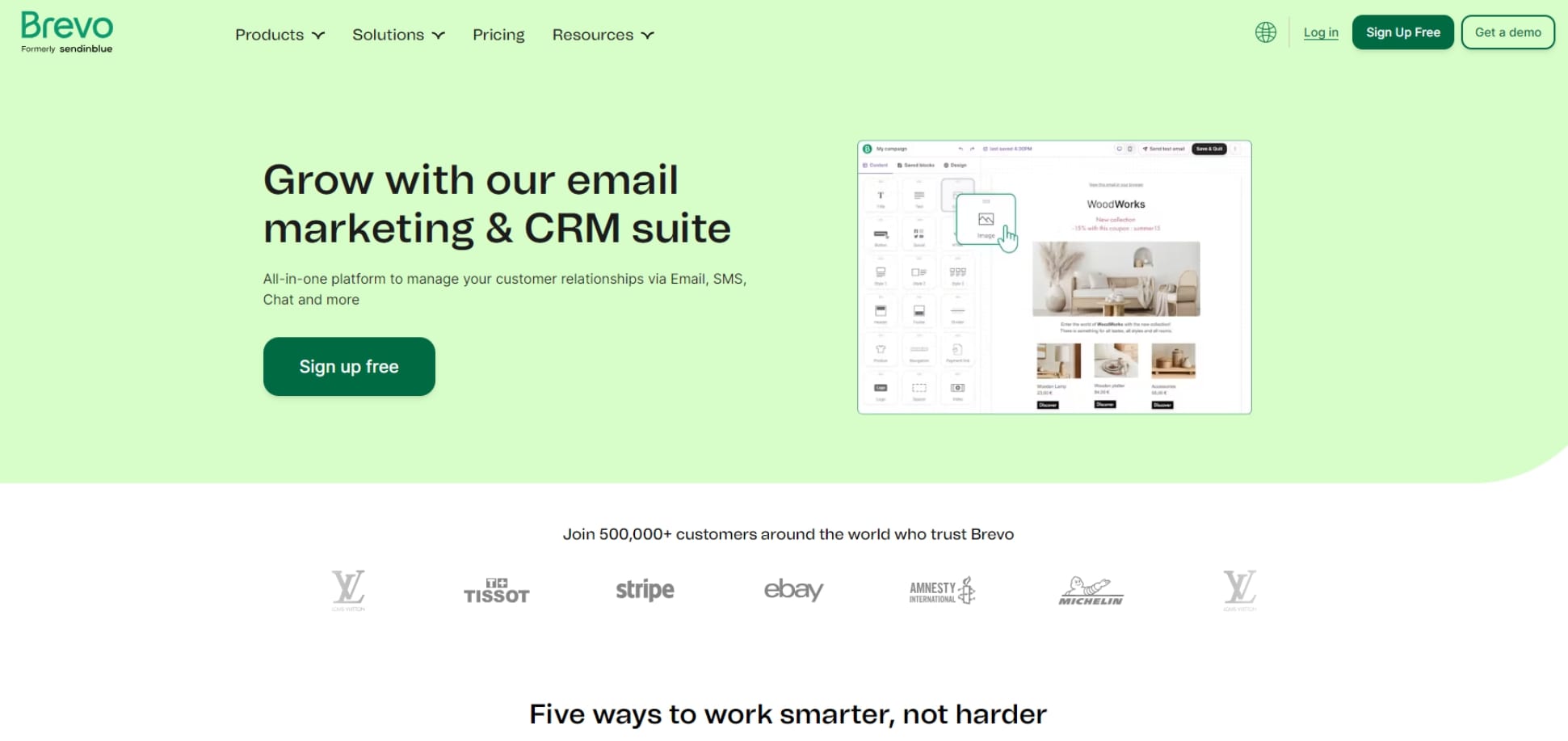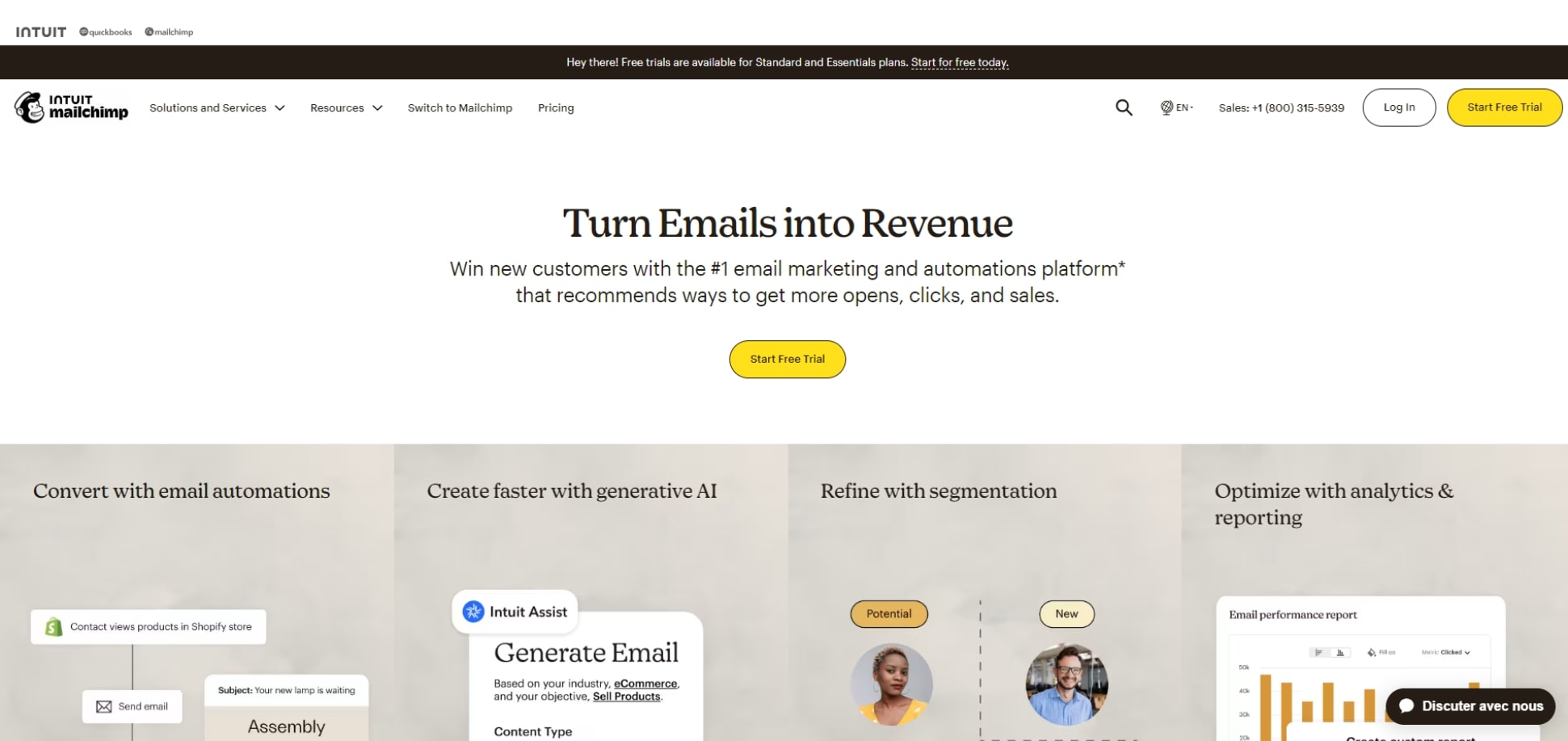ActiveCampaign is a powerful email and customer relations management (CRM) platform that lets you run marketing campaigns to nurture leads, drive sales, and increase brand awareness. But this tool is not for everyone. In this quick guide, we’ll show you 4 great alternatives to ActiveCampaign.
ActiveCampaign was created back in 2003. And since then, this emailing app has kept on growing to become a full-fledged marketing platform that lets you create emails, landing pages, and SMS campaigns.
It comes with a truckload of advanced features, such as social media integration, segmentation, live chat, a unified inbox, lead scoring, and more – allowing you to run omnichannel marketing and automating personalized customer experiences to grow your business.
This is why ActiveCampaign has become tremendously popular over the years, boasting over 180,000 customers all over the world. But this marketing platform is not perfect. In fact, it has quite a few flaws ⤵️
- Steep learning curve – There are TONS of features in ActiveCampaign. Which is great if you’re a black belt marketer. But if you simply want to send email campaigns, this can feel a bit overwhelming.
- Not budget friendly – ActiveCampaign is powerful. But it’s also quite expensive. Their cheapest plan starts at $29 a month billed annually (or $39 a month billed monthly). And it only includes basic features.
- CSV files only – You can import your existing contact list and segment your audience. But ActiveCampaign only allows you to upload CSV files. If your team is used to working with XLSX (which is an industry standard), you’ll need to adapt.
- Basic templates – ActiveCampaign lets you choose out of 180+ email and landing page templates. Which is great. Especially if you don’t have a designer in your team. But the templates are really basic.
- No free plan – Unlike other popular emailing tools, such as Mailmeteor, ActiveCampaign doesn’t offer a free plan. If you want to use this solution you’ll have to pay. Even if you have (very) simple needs.
- No stock images – Lastly, unlike other competitors, such as Brevo, ActiveCampaign doesn’t have a built-in stock image library. So you’ll need to import your own visuals, which can be time-consuming.
Fortunately, there are plenty of alternatives that can help you grow your business, outperform your competitors, and turn leads into deals.
As seasoned marketers with a proven track record of 1,000+ email campaigns, we’ve tried A LOT of emailing apps over the years.
A lot of them were terrible. But we came across a handful of gems that can easily compete with ActiveCampaign.
In this quick guide, we’ll review 4 of the best ActiveCampaign alternatives to help you find THE emailing platform that fits your needs:
Sounds good? Then let’s dive in.
1. Mailmeteor
Mailmeteor is a world-acclaimed emailing platform, trusted by over 6 million users worldwide. This privacy-focused application is rated 4,9/5 on the Google Workspace Marketplace out of 11,000+ reviews.
In 2024, Mailmeteor was listed as one of the 16 Recommended for Google Workspace apps. And it’s often considered as one of the most affordable alternatives to ActiveCampaign when it comes to sending emails.
This tool is used by small businesses, but also major companies like Spotify, Uber and Pinterest. It’s a great ActiveCampaign substitute if you need to dispatch personalized emails at scale to grow your business and connect with your audience.

Pros of Mailmeteor
Mailmeteor does only one thing. It helps you send personalized emails at scale and build meaningful connections with your audience. But it does this like no other email marketing platform out there.
The solution is super intuitive. No steep learning curve like it’s the case with ActiveCampaign. You can create your first email and set up powerful outreach campaigns in minutes. No technical skills required.
This ActiveCampaign alternative lets you send up to 2,000 personalized emails a day. You can also schedule campaigns, track your emails in real-time, and manage unsubscribe requests to comply with regulations, like GDPR and CAN-SPAM.
What’s more, Mailmeteor works wherever you work. You can prepare your campaigns in the dashboard, or mail merge in Google Sheets. Heck, you can even send your campaigns directly from your inbox thanks to the new Gmail extension.
Mailmeteor is designed to help you reach your recipient’s inbox and navigate the spam filters. This tool offers unparalleled deliverability thanks to advanced emailing features, such as:
- Email throttling – Add a delay between each message to mimic a normal sending activity and boost your deliverability rates.
- Email verification – Our BounceShield automatically verifies all your email addresses to prevent bounces.
- Custom domain – Get your own brand-centric custom domain to track open and clicks without damaging your sender reputation.
This emailing software also lets schedule conditional follow-ups and automate entire email sequences, allowing you to send timely responses to your leads, and scale your cold outreach strategy, even with limited resources.
Last but not least, Mailmeteor was built to respect your privacy. Unlike other mail merge tools, this program doesn’t request permission to read your emails. The content of your inbox stays secure and private.
Cons of Mailmeteor
But Mailmeteor has some flaws. For starters, this mail merge abides by the Gmail daily send limitations. Which means that you can only send up to 2,000 emails a day with a Google Workspace account. For most marketers and sales reps, this is more than enough. Especially if you want to focus on cold outreach, with ultra-targeted email campaigns. However, if you plan to send newsletters or blast emails, this may require splitting a large email list over multiple days, which isn’t ideal for time-sensitive emails.
Moreover, Mailmeteor only works with Gmail and Outlook. This tool integrates seamlessly with the Google products, like Sheets. But if you’re using another email provider, like Yahoo Mail, AOL Mail, or ProtonMail, this may not be the best ActiveCampaign alternative for you.
Another limitation of this tool is that Mailmeteor excels at emailing. But it doesn’t do much beyond that. You can’t send SMS campaigns, create landing pages, or design forms, like you can with ActiveCampaign. If you’re looking for a complete marketing suite and you have a large budget, ActiveCampaign is your best bet. But if you simply want to send stellar emails at scale and grow your business, Mailmeteor is a cheaper, more intuitive, and overall more effective alternative.
Mailmeteor Pricing
Mailmeteor doesn’t have a 14-day free trial like ActiveCampaign. Instead, we offer a generous free plan that lets you send up to 50 personalized emails a day.
You can keep using Mailmeteor for free for as long as you want. Or you can subscribe to one of our paid plans if you want to send even more emails.
The good news is that our plans are much more affordable than ActiveCampaign. You have three different options:
- Mailmeteor Premium – Send up to 15,000 emails for $9.99 a month and access basic features, such as live tracking.
- Mailmeteor Pro – Send up to 45,000 emails for $24.99 a month, schedule follow-ups, and automate email sequences.
- Mailmeteor Business – Send up to 60,000 emails for $49.99 a month with custom domain tracking and unlimited aliases.
2. ConvertKit
ConvertKit is yet another great substitute for Quickmail. This emailing platform was created in 2013 by Nathan Barry, a blogger that needed a better way to reach his audience and sell courses through email.
ConvertKit is now used by 600,000+ creators and solopreneurs to grow their revenue 1 email at a time. The app is rated 4.7/5 on Capterra and 4.4/5 on G2. But it only has 200+ reviews on each of these platforms.

Pros of ConvertKit
ConvertKit is much easier to use than ActiveCampaign. The interface is clean and straightforward. And there is an extensive knowledge base that can answer pretty much any question you might have about the app.
This tool allows you to automate entire campaigns effortlessly thanks to a visual workflow builder. It also has 25+ pre-built automation templates that can help you run your business even during your sleep.
You can also organize your contacts and segment your audience with tags and segments. And if you have a Creator Pro plan, you can even unlock a lead scoring tool to pinpoint your most engaged subscribers.
ConvertKit also has a landing page builder, with nice templates to get you started, and a drag & drop email builder that lets you create beautiful messages even if you don’t know how to code in HTML.
Last but not least, this ActiveCampaign substitute lets you monetize your content thanks to built-in e-commerce features. You can also start a paid newsletter, and generate new revenues by recommending other creators.
This is something you can’t find in other emailing tools, like Mailmeteor and ActiveCampaign. Which is why ConvertKit is a great alternative for content creators and bloggers.
Cons of ConvertKit
However, ConvertKit is not for everyone. You can personalize your emails by adding the name of your recipient with 1 simple click. But for more advanced personalization, you’ll need some coding knowledge.
What’s more, just like with ActiveCampaign, ConvertKit only supports CSV files. So you can import contacts from a Google Sheet or copy and paste their email address, like you can with more intuitive tools, such as Mailmeteor.
The landing page builder comes with 50+ modern and elegant templates that you can host on ConvertKit or your own website. But the options to personalize these templates are limited to say the least.
The email deliverability of ConvertKit used to be outstanding. But lately, it’s been fluctuating. So if you want your messages to reach your recipient’s inbox more consistently, you’re better off using tools with stellar deliverability rates, like ActiveCampaign or Mailmeteor.
Lastly, while ConvertKit has recently improved its analytics dashboard, this ActiveCampaign replacement doesn’t offer advanced reporting, like heat maps, geo-tracking, and other useful metrics.
ConvertKit Pricing
ConvertKit is also cheaper than ActiveCampaign. They have a free plan that lets you build your list and contact up to 1,000 subscribers. Beyond that, you’ll need to choose one of their paid plans.
The pricing system is the same as ActiveCampaign. The more contacts you add, the more you pay. If you have more than 1,000 subscribers, you’ll no choice but to upgrade to one of ConvertKit’s paid plans:
- Creator – It costs $25 a month for 1,000 subscribers + you get access to additional features, like free migration from another tool, automated email sequences, and paid recommendations.
- Creator Pro – The price goes up to $50 a month for 1,000 subscribers + you unlock advanced features, such as access to ConvertKit’s newsletter referral system, subscriber scoring, and advanced reporting.
This alternative can get a bit pricey if you have a large email list. But it’s still more budget-friendly than ActiveCampaign, which is why a growing number of creators are switching to ConvertKit.
3. Brevo
Brevo (formerly known as Sendinblue) is a French email marketing tool that was created in 2012. This ActiveCampaign alternative is rated 4.5/5 out of 1,900+ reviews on Capterra and 4,2/5 out of 4 400+ reviews on TrustPilot.
In the last 10 years, Brevo has convinced over 500,000 companies all around the world thanks to its intuitive interface, and its competitive pricing strategy. But is that enough to make it stand out from ActiveCampaign?

Pros of Brevo
Just like ActiveCampaign, Brevo wants to do more than emails. This tool offers a complete marketing platform, with CRM capabilities, a landing page builder, SMS campaigns, automation, forms, and more.
The interface is clean and intuitive. You can create emails from scratch or edit an existing template. The email builder has a simple drag & drop system that lets you design beautiful emails almost effortlessly.
You can add call-to-actions (CTA), images, dynamic content, and take your pick from different layouts. This is very handy. Especially if you want to create a corporate newsletter or transactional emails.
This ActiveCampaign alternative also lets you create unlimited contact lists and segment your audience. You can build your list by customizing forms and enabling special fields to comply with the latest data protection regulations, like GDPR.
Brevo has a visual automation builder that lets you design tailored customer experience and automate your business. This tool is incredibly simple to use. No need to know how to code.
In our experience, Brevo is great for e-commerce and small or medium-sized businesses that want an affordable tool to send branded newsletters, transactional emails, and SMS campaigns or WhatsApp messages.
Cons of Brevo
Brevo is a strong alternative to ActiveCampaign. But when we tried this marketing platform, we realized that it was lacking a few things.
The landing page builder is a bit clunky. And it doesn’t support that many third-party integrations, compared to ActiveCampaign.
But the main issue with Brevo is that this tool’s email deliverability is quite poor (around 85% based on a series of tests).
This is much lower than what you can get with high-performance email platforms such as Mailmeteor, ConvertKit, or ActiveCampaign.
Last but not least, if you’re using Brevo’s Starter plan, you’ll need to pay an extra €9 a month to remove the Brevo branding.
Brevo Pricing
Brevo has a free plan that lets you send up to 300 emails per day. You get unlimited access to a drag & drop editor, transactional emails, SMS & WhatsApp campaigns, and customizable email templates.
This solution is more affordable than ActiveCampaign. The price varies based on the number of emails you need to send each month.
By default, Brevo’s paid plans let you send up to 20,000 emails a month. You can increase your monthly email quota. But this comes at a price.
Brevo has three different paid plans. Each plan gives you access to different features of their marketing suite:
- Starter – For $19 a month, you can send up to 20,000 emails + Everything in Free + basic reporting and email support.
- Business – For $49 a month, you can send up to 20,000 emails + Everything in Starter + marketing automation, A/B testing, advanced statistics, multi-user access, phone support, and AI-powered predictive sending.
- Enterprise – For a custom price, you can send up to 20,000 emails + Everything in Business + tailored onboarding, personalized support, advanced integrations, and enterprise-grade security.
4. Mailchimp
Mailchimp is one of the oldest emailing platforms on the market. It was founded more than 20 years ago. At that time, it revolutionized the email marketing industry. Its main strength was its intuitive user experience.
Today, Mailchimp is still one of the most famous emailing software. And depending on your needs, it can be a great replacement for ActiveCampaign. This email program is rated 4.4/5 out of 5,000+ reviews on G2.

Pros of Mailchimp
Mailchimp is a reputable alternative to ActiveCampaign. And it’s easy to see why. This platform offers a ton of features that can help you run effective inbound marketing campaigns at scale.
You can create ultra-targeted email campaigns thanks to Mailchimp’s personalization feature. Add merge tags and dynamic content to your emails to make each recipient feel unique.
Mailchimp also added a copy optimization option (still in beta) to help you write more engaging emails and connect with your audience. We gave it a try, and the results are actually pretty decent.
This emailing software also added a feature called Customer Journeys that let you create automated email sequences and follow-ups. It’s easy to use. Even if you don’t know how to code.
Another strong point of Mailchimp is that, much like ActiveCampaign, you can integrate this platform with the tools you already love. This app offers 300+ integrations to help you streamline your marketing and scale your business.
Cons of Mailchimp
Mailchimp was created a while ago. And while the tool keeps evolving, the interface can feel a bit clunky and outdated. It’s definitely not as intuitive as other emailing software, such as Mailmeteor or ConvertKit.
What’s more, the landing page builder is limited. You can’t add custom HTML to customize your landing pages and make them look like your website. And A/B testing is available for emails. But not with landing pages.
Mailchimp recently implemented an Inbox Preview tool that lets you see how your campaigns will look in different email clients. Unfortunately, you have to pay extra to access this add-on. And it’s not cheap.
Last but not least, Mailchimp charges you based on the number of contacts you have in your list. Which is pretty standard. But unlike most platforms, this ActiveCampaign substitute charges you for unsubscribed and inactive contacts.
Mailchimp Pricing
Mailchimp is expensive. But it’s still cheaper than ActiveCampaign. They have a free plan that lets you send emails to up to 500 contacts.
But beyond that limit you’ll need to switch one of their paid plans. Basically, MailChimp gives you three options
- Essentials – For $26.50 a month, you can send up to 15,000 emails and add 1,500 contacts + get access to forms, landing pages, and limited analytics.
- Standard – For $45 a month, you can send up to 18,000 emails and add 1,500 contacts + get a campaign manager and add dynamic content to your emails.
- Premium – For $350 a month, you can send up to 150,000 emails and add 1,500 contacts + get priority phone support.
If you want to send more emails, or add more contacts, the prices quickly go up and reach several hundred dollars a month. So it’s not for everybody.
Conclusion
ActiveCampaign is a top-tier customer experience automation platform that lets you build omnichannel marketing strategies and send the right messages to your clients at the right time. This SaaS is (very) popular among big companies with large marketing teams, or marketing agencies.
But it’s not for everyone. Because ActiveCampaign is expensive and has a steep learning curve. So it’s less than ideal for small and medium companies, freelancers, and solopreneurs.
Fortunately, there are many great ActiveCampaign alternatives out there. Our favorites are Mailmeteor (the cheapest and easiest one), ConverKit (ideal for content creators), Brevo (great for newsletters), and MailChimp.
Make sure to test a few emailing platforms before picking one. Most of them have a free trial, or even better, a free plan. This is a great way to start exploring a tool and its features before switching to a paid plan.
At Mailmeteor, for example, you can send up to 50 emails a day for free. There is no time limit. So you can keep using our app at zero cost for as long as you want. Why not give it a try and let us know what you think?
Happy sending :)


